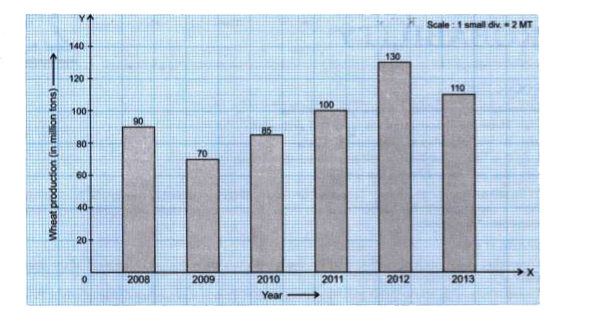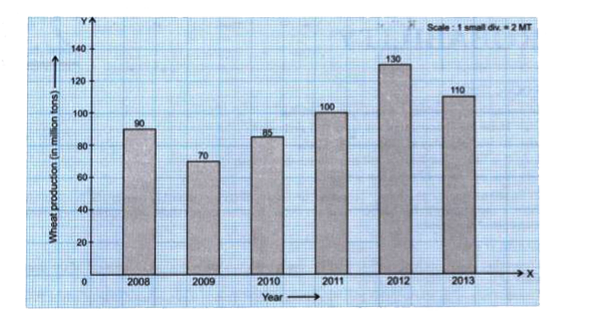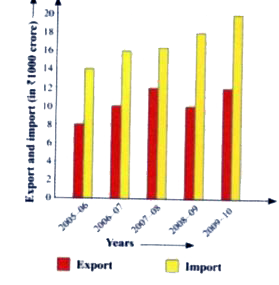The following data gives the amount of manure (in thousand tonnes) manufactured by a company during some years: Year 1992 1993 1994 1995 1996 1997 Production (in Thousand tonnes) 15 35 45 30 40 20 Represent the above data with the help of a bar graph. Indicate with the help of the bar graph the year in which the amount of manufactured by the company was maximum. Choose the correct alternative: The consecutive years during which there was maximum decrease in manure production are: 1994 and 1995 (b) 1992 and 1993 1996 and 1997 (d) 1995 and 1996
To solve the problem, we will represent the given data in a bar graph and analyze it to find the year with maximum production and the consecutive years with maximum decrease in production.
1. Data Representation:
- We have the following data:
- Year: 1992, 1993, 1994, 1995, 1996, 1997
- Production (in thousand tonnes): 15, 35, 45, 30, 40, 20
2. Draw the Axes:
- Draw the horizontal axis (x-axis) for the years.
- Draw the vertical axis (y-axis) for the production in thousand tonnes.
3. Label the Axes:
- Label the x-axis with the years: 1992, 1993, 1994, 1995, 1996, 1997.
- Label the y-axis with production values. Use intervals of 10, so the y-axis will have values: 0, 10, 20, 30, 40, 50.
4. Plot the Bars:
- For each year, draw a bar whose height corresponds to the production value:
- For 1992: Draw a bar up to 15 (between 10 and 20).
- For 1993: Draw a bar up to 35 (between 30 and 40).
- For 1994: Draw a bar up to 45 (between 40 and 50).
- For 1995: Draw a bar up to 30 (between 20 and 40).
- For 1996: Draw a bar up to 40 (between 30 and 50).
- For 1997: Draw a bar up to 20 (between 10 and 30).
5. Identify Maximum Production:
- From the plotted bars, observe that the tallest bar corresponds to the year 1994, which has a production of 45 thousand tonnes. This indicates that the maximum production occurred in 1994.
6. Calculate Decreases:
- Now, analyze the production values to find the maximum decrease:
- From 1992 to 1993: Increase of 20 (15 to 35)
- From 1993 to 1994: Increase of 10 (35 to 45)
- From 1994 to 1995: Decrease of 15 (45 to 30)
- From 1995 to 1996: Increase of 10 (30 to 40)
- From 1996 to 1997: Decrease of 20 (40 to 20)
7. Identify Maximum Decrease:
- The maximum decrease in production occurred between the years 1996 and 1997, where the production dropped from 40 to 20, a decrease of 20 thousand tonnes.
8. Final Answers:
- The year with maximum production: 1994
- The consecutive years with maximum decrease in production: 1996 and 1997
- We have the following data:
- Year: 1992, 1993, 1994, 1995, 1996, 1997
- Production (in thousand tonnes): 15, 35, 45, 30, 40, 20
- Draw the horizontal axis (x-axis) for the years.
- Draw the vertical axis (y-axis) for the production in thousand tonnes.
- Label the x-axis with the years: 1992, 1993, 1994, 1995, 1996, 1997.
- Label the y-axis with production values. Use intervals of 10, so the y-axis will have values: 0, 10, 20, 30, 40, 50.
- For each year, draw a bar whose height corresponds to the production value:
- For 1992: Draw a bar up to 15 (between 10 and 20).
- For 1993: Draw a bar up to 35 (between 30 and 40).
- For 1994: Draw a bar up to 45 (between 40 and 50).
- For 1995: Draw a bar up to 30 (between 20 and 40).
- For 1996: Draw a bar up to 40 (between 30 and 50).
- For 1997: Draw a bar up to 20 (between 10 and 30).
- From the plotted bars, observe that the tallest bar corresponds to the year 1994, which has a production of 45 thousand tonnes. This indicates that the maximum production occurred in 1994.
- Now, analyze the production values to find the maximum decrease:
- From 1992 to 1993: Increase of 20 (15 to 35)
- From 1993 to 1994: Increase of 10 (35 to 45)
- From 1994 to 1995: Decrease of 15 (45 to 30)
- From 1995 to 1996: Increase of 10 (30 to 40)
- From 1996 to 1997: Decrease of 20 (40 to 20)
- The maximum decrease in production occurred between the years 1996 and 1997, where the production dropped from 40 to 20, a decrease of 20 thousand tonnes.
- The year with maximum production: 1994
- The consecutive years with maximum decrease in production: 1996 and 1997
Topper's Solved these Questions
Similar Questions
The following data gives the amount of manure (in thousand tonnes) manufactured by a company during some years: year 1992 1993 1994 1995 1996 1997 Manure (in thousand tonnes) 15 35 45 30 40 20 (i) Represent the above data with the help of a bar graph. (ii) Indicate with the help of the bar graph the year in which the amount of manufactured by the company was maximum. (iii) Choose the correct alternative: The consecutive years during which there was maximum decrease in manure production are: (a 1994 and 1995 (b) 1992 and 1993(c) 1996 and 1997 (d) 1995 and 1996
View SolutionThe following data gives the amount of manure (in thousand tonnes) manufactured by a company during some years: Year, 1992, 1993, 1994, 1995, 1996, 1997 Manure (In thousand tonnes), 15, 35, 45, 30, 40, 20 Represent the above data with the help of a bar graph. Indicate with the help of the bar graph the year in which the amount of manure manufactured by the company was maximum. Choose the correct alternative: The consecutive years during which there was maximum decrease in manure production are: 1994 to 1995 (b) 1992 and 1993 1996-1997 (d) 1995 and 1996
View SolutionRead the bar graph given below :

In which year there was maximum increase in production of wheat?
View SolutionRead the bar graph given below :

In which year the production was minimum?
View SolutionWhich one of the following has not changed for the last several thousand years
View SolutionInsulin was manufactured commercially at first by which company ?
View SolutionThe following data gives the production of foodgrains (in thousand tonnes) for some years: Year , 1995, 1996, 1997, 1998, 1999, 2000 Production (in Thousand tonnes), 120, 150, 140, 180, 170, 190 Represent the above data with the help of a bar graph.
View SolutionRead the bar graph given below :

Find the percentage increase in wheat production in the year 2012.
View SolutionRead the bar graph and answer the following questions.
in which year the value of the export is greater than that of the import?

View SolutionThe following table shows the favourite sports of 250 students of a school. Represent the data by a bar graph.
View Solution
